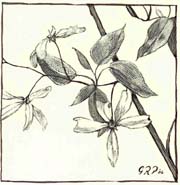 |
|||||||||||||||||||||||||||||||||
|
|||||||||||||||||||||||||||||||||
|
Why Does the Servicetree Bloom?As the shadbush flowers, few of its namesake travel our watersI learned about Amelanchier canadensis on a spring bird walk. The leader was an amazing guy who knew everything about the park where we were birding. It was almost as if he could conjure birds out of thin air. Do you ever see cedar waxwings? I asked, and right away he pointed to a flock flying over the marsh. When asked about orioles, he found one singing in a sycamore over there. He was a revelation. Amelanchier canadensis is no bird. It’s a tree with several names, one of True or not, it is a great story. I tried to look into it. But Donald Culross Peattie author of The Natural History of Trees, thinks that the name refers to the tasty berries the tree produces. He wrote that serviceberry is a “genteel corruption” of sarviss, which is itself a variation of sorbus, which is a Latin name for a similar kind of fruit. Peattie prefers the name Sarvisstree. You might know the tree by one of its many other names: Juneberry, May-Cherry or Shadbush. Shadbush or shadblow are names most meaningful around the Chesapeake and its tributaries. The blooming of the Shadbush meant that it was time for the first fish of the year to run. The spring shad run was a major cultural event and very important economically in the tidewater communities. Today shad are threatened, but there was a time when the bony fishes swarmed up the Chesapeake from the salty Atlantic to reach freshwater breeding grounds. Their numbers were so great that they sometimes overwhelmed nets and swamped boats. The egg-laden females that follow the males upriver are prized for their roe, which is what the eggs are called. This year as the flower buds of the shadbush swell and open, we read the news of other Bay species facing difficult times. A wasting disease is reported to be affecting three-quarters of the Bay’s rockfish. Scientists point to pollution as the cause. Meanwhile large-scale commercial fishing threatens menhaden, an important food source for the rockfish. The tree still blooms, but if the rockfish are dying while the menhaden are disappearing and shad don’t run as they used to, maybe it is just a Servicetree. |
||||||||||||||||||||||||||||||||
|
|
|||||||||||||||||||||||||||||||||
|
© COPYRIGHT 2004 by New Bay Enterprises, Inc. All rights reserved. |



 them legendary. Serviceberry is what he called the medium-sized tree covered with white flowers. That name, he said, had to do with funerals. In areas where the ground freezes solid, people couldn’t bury their dead until the spring thaw. So they stored their corpses and waited until the Serviceberry blossomed to have funeral services.
them legendary. Serviceberry is what he called the medium-sized tree covered with white flowers. That name, he said, had to do with funerals. In areas where the ground freezes solid, people couldn’t bury their dead until the spring thaw. So they stored their corpses and waited until the Serviceberry blossomed to have funeral services.